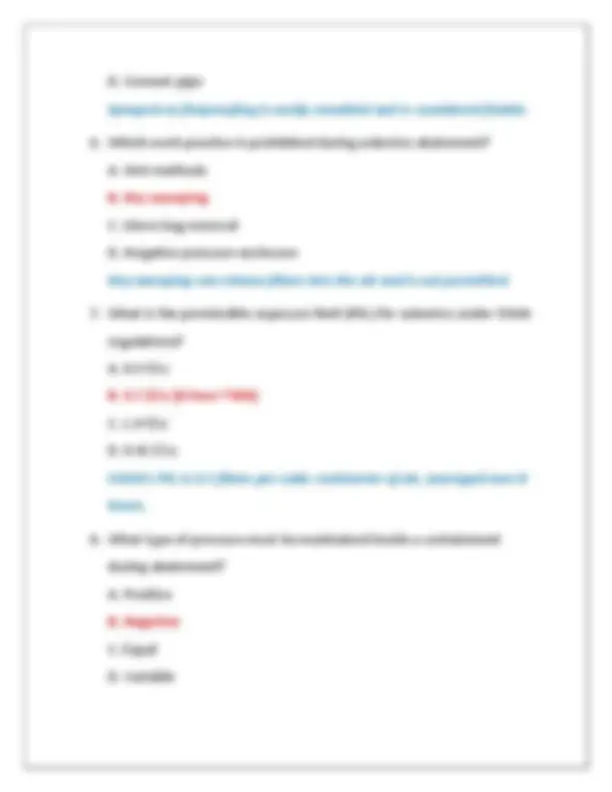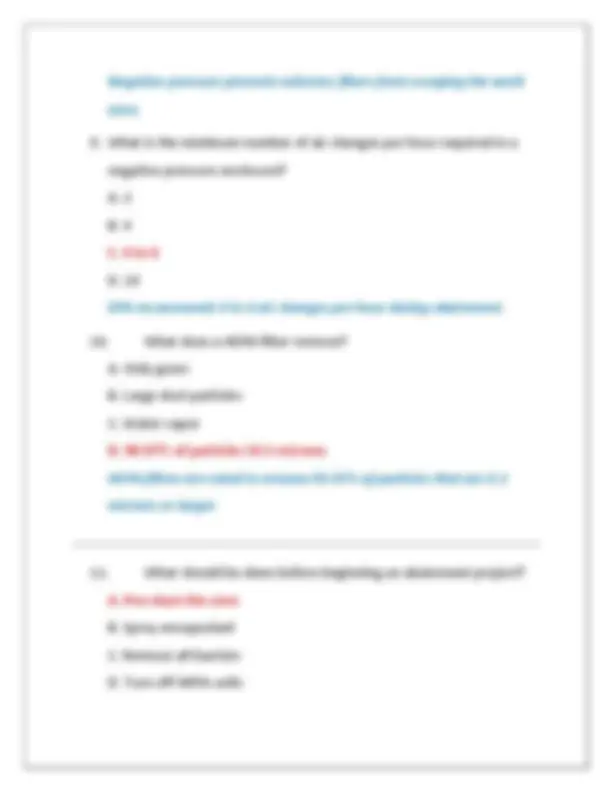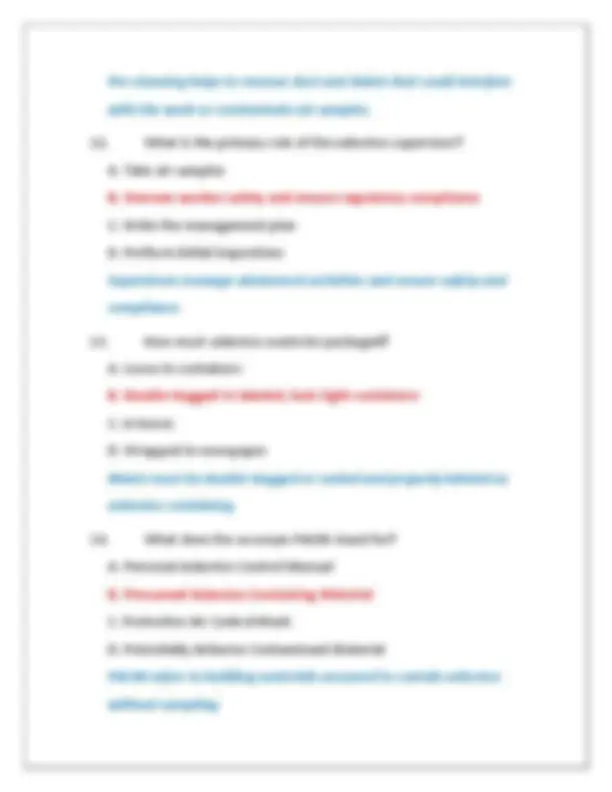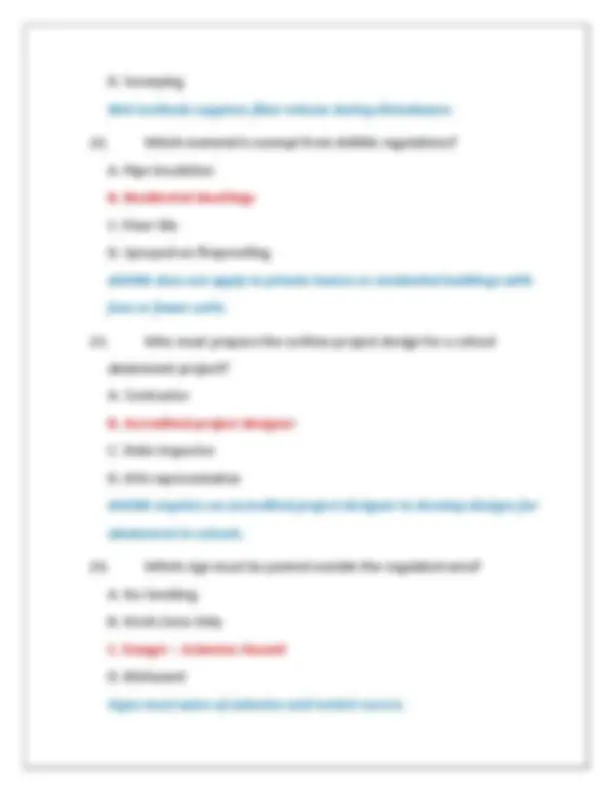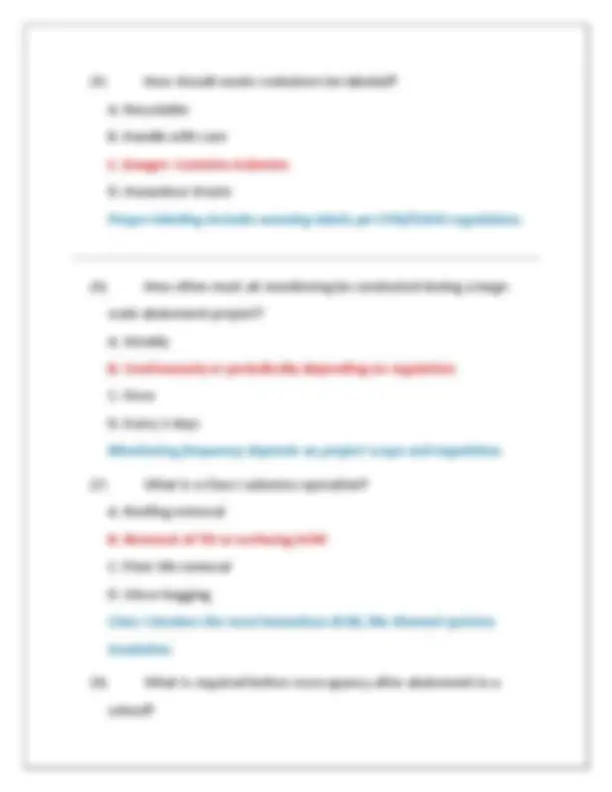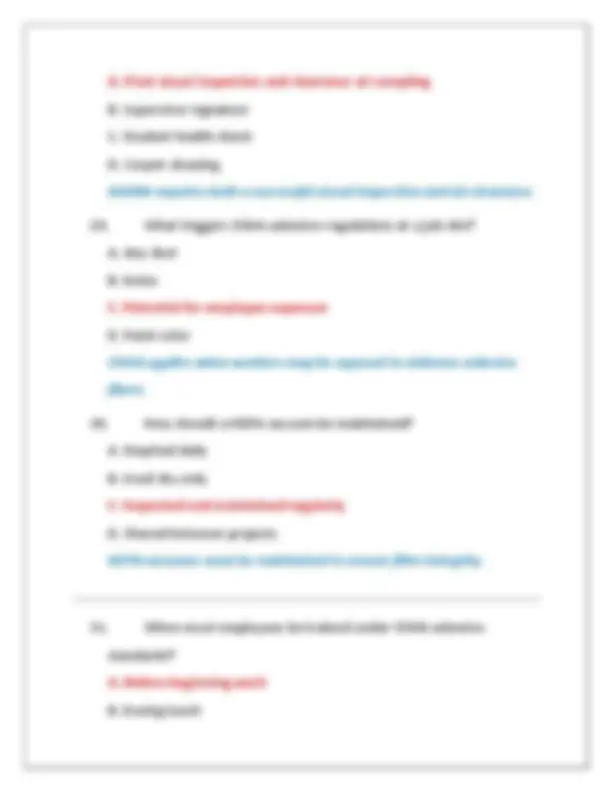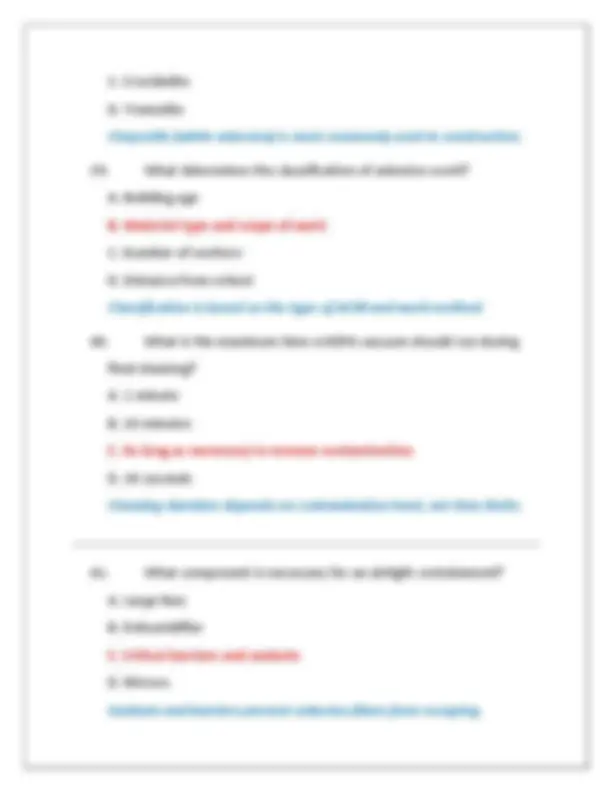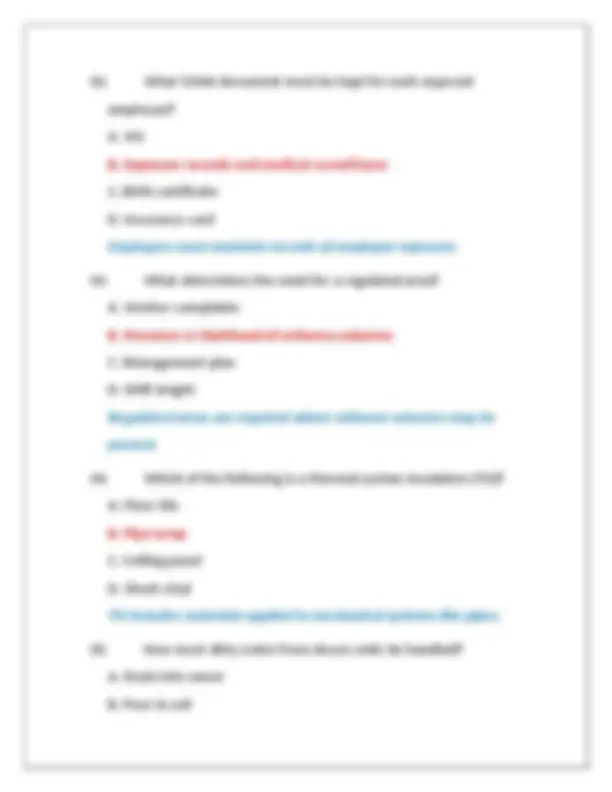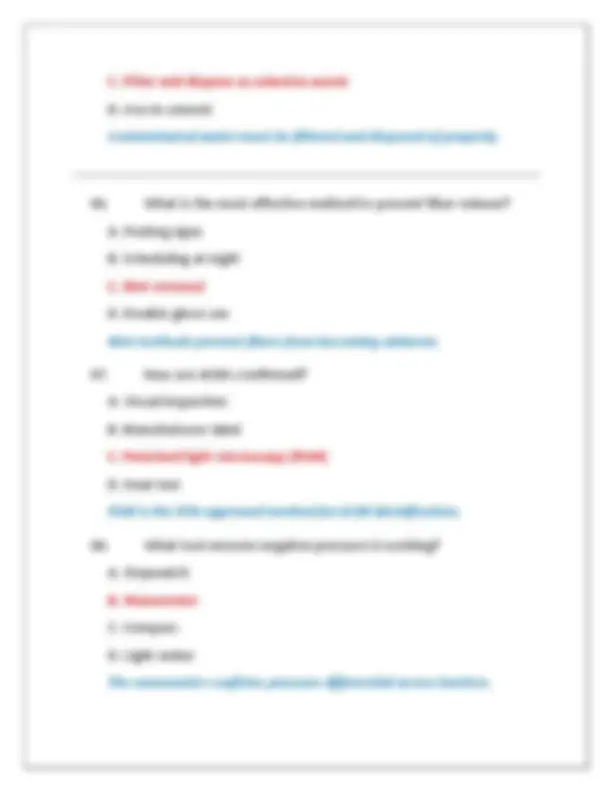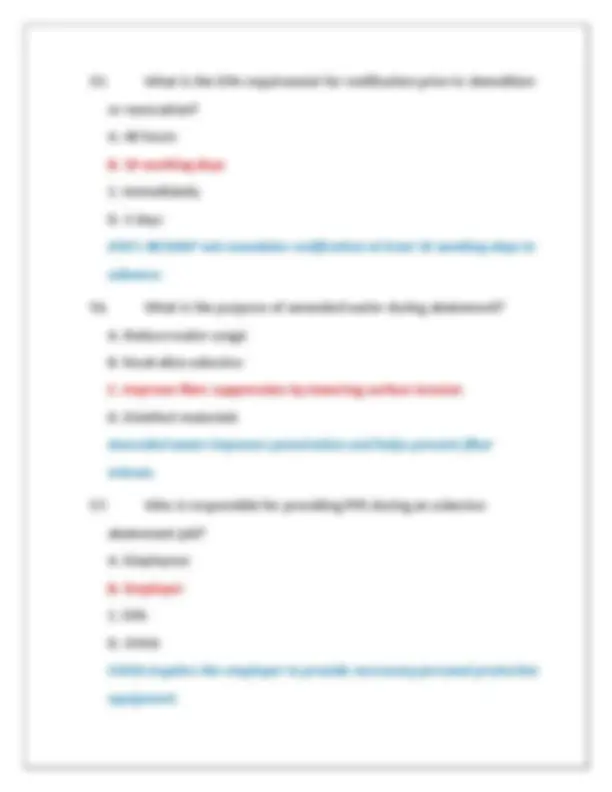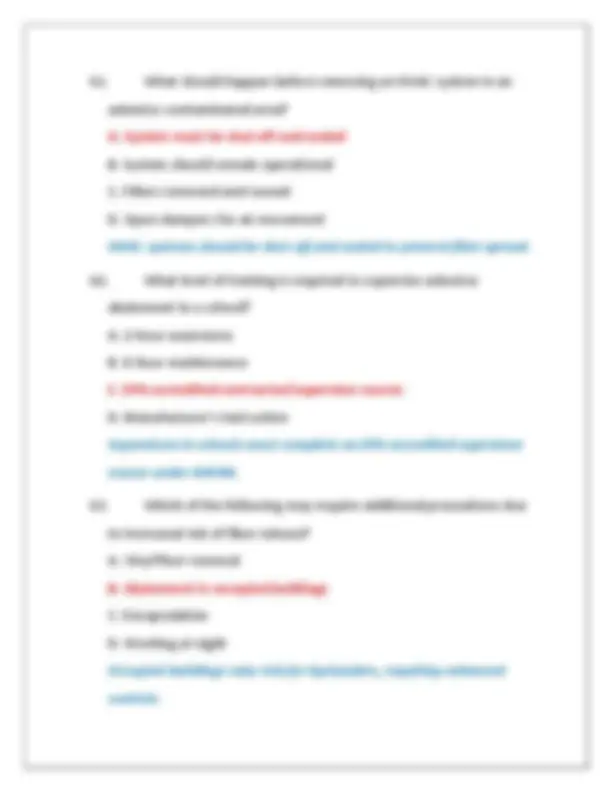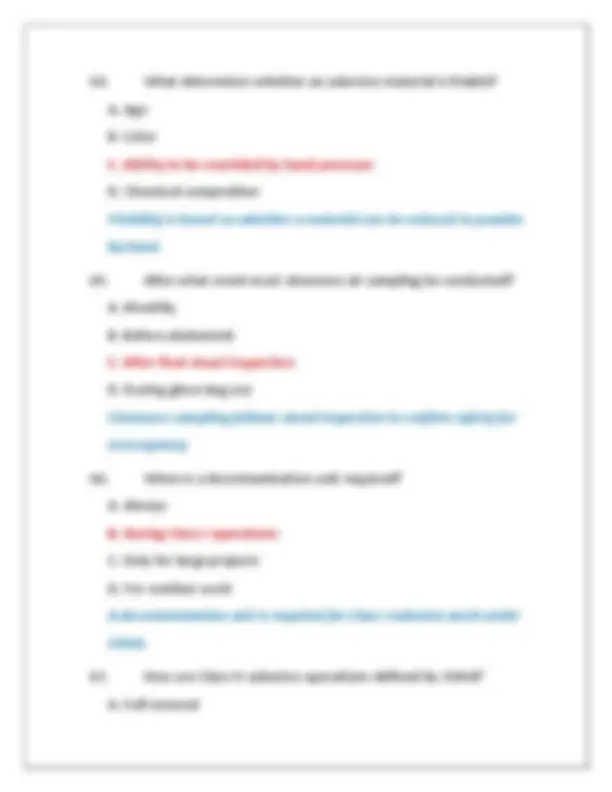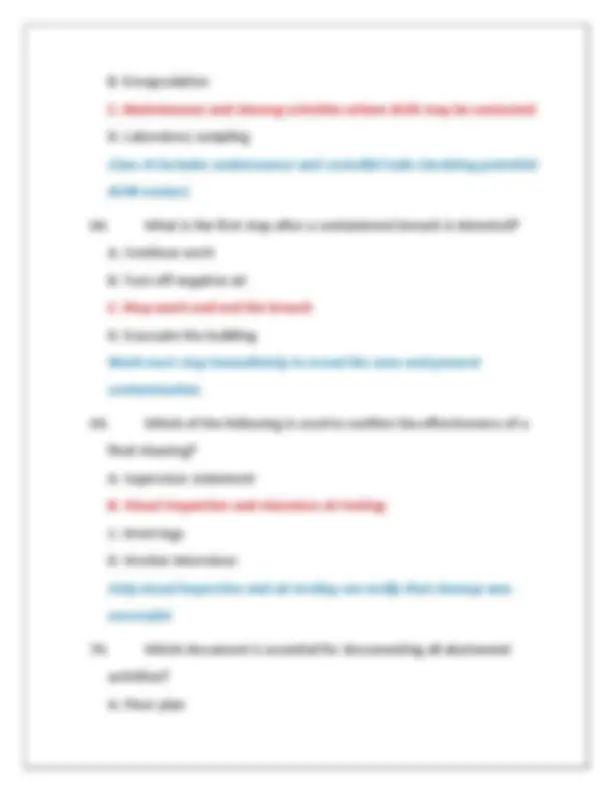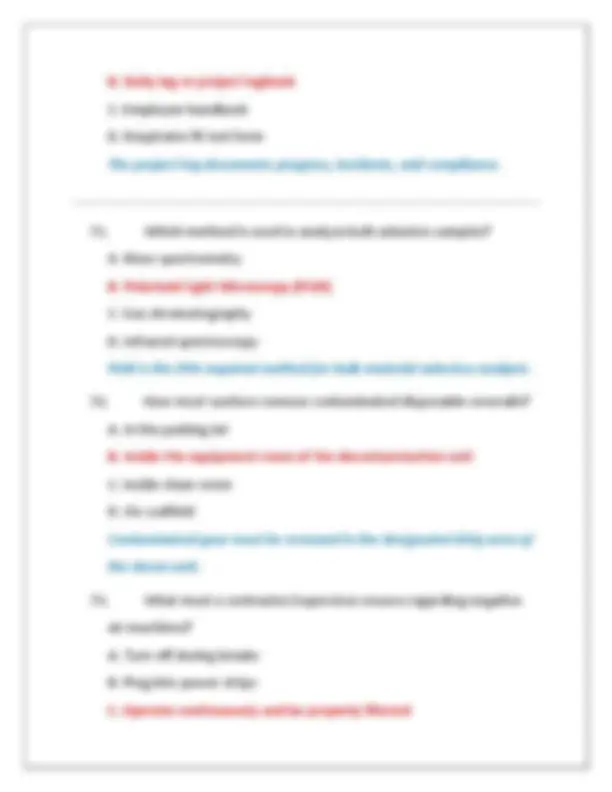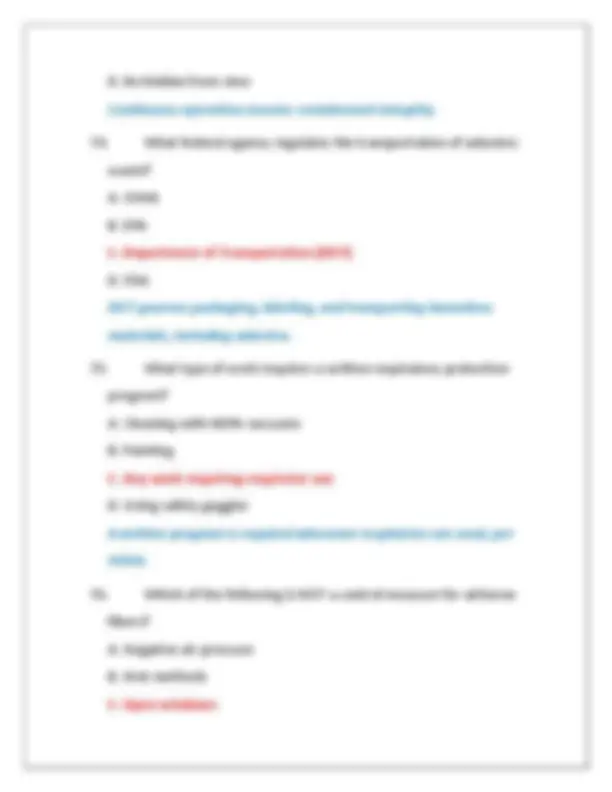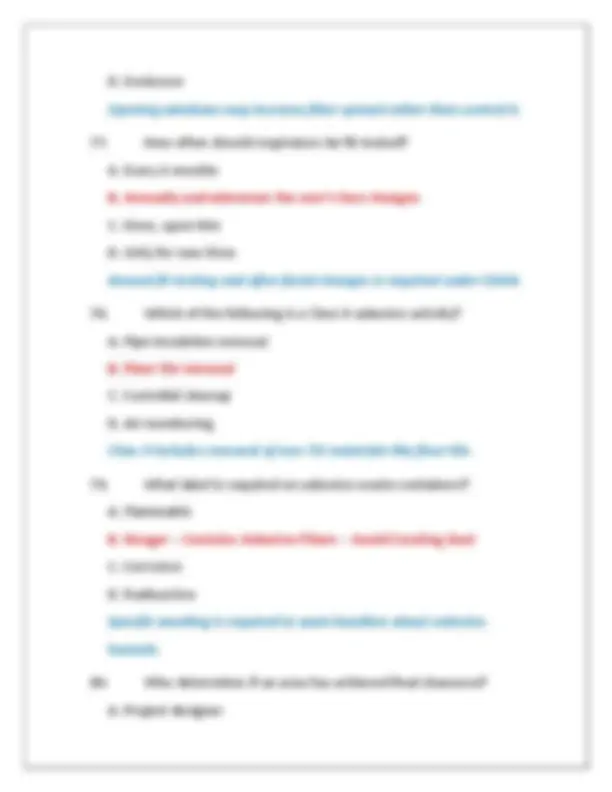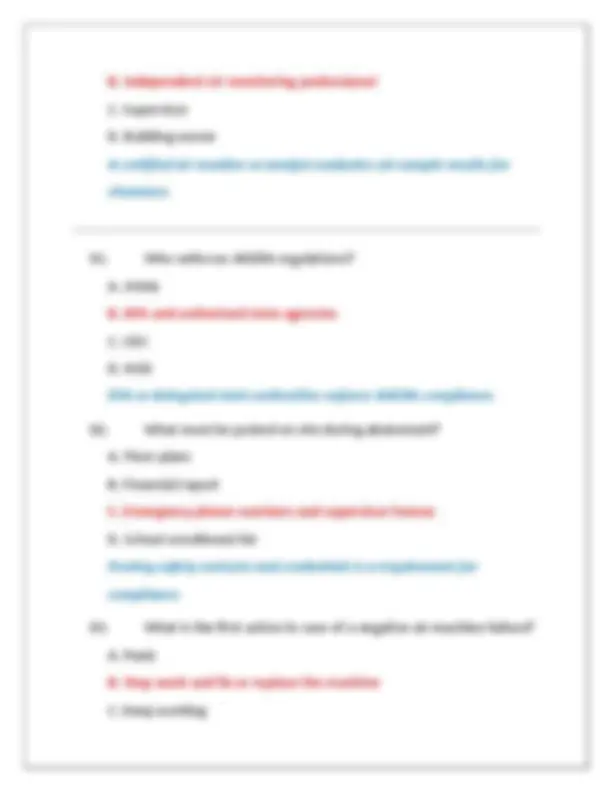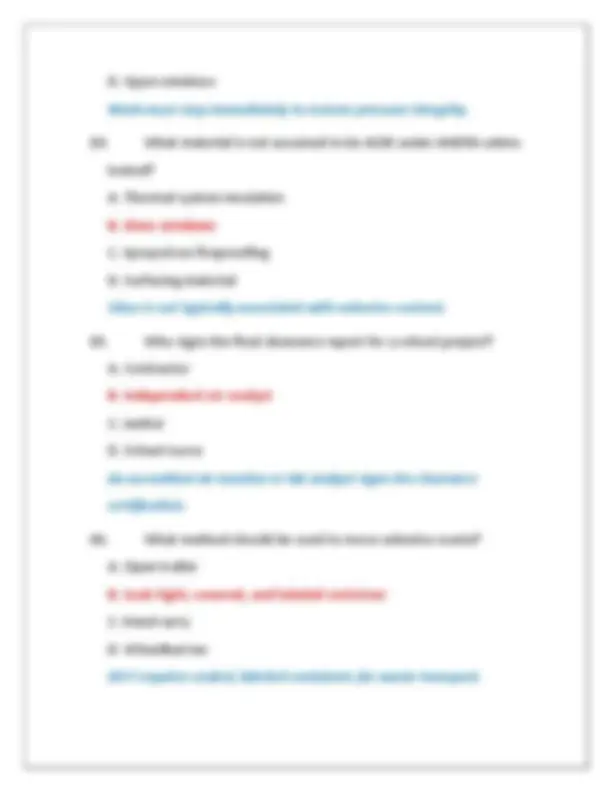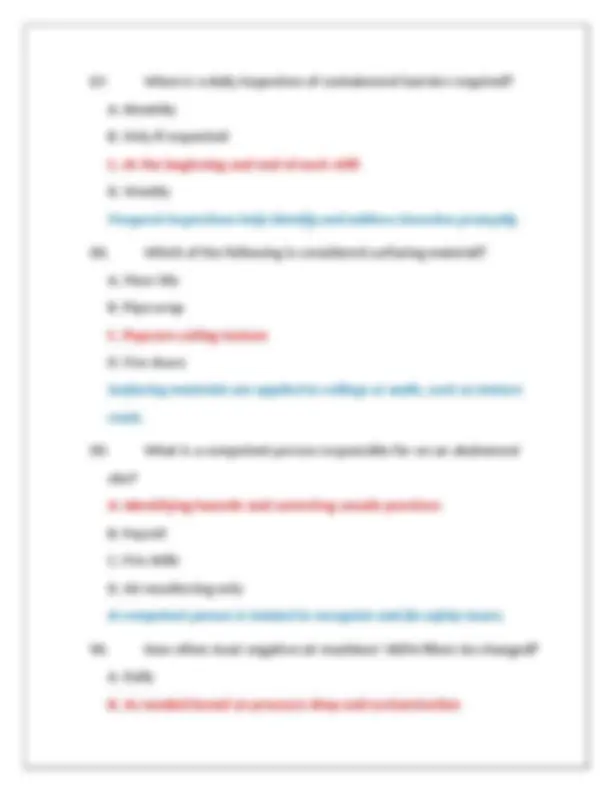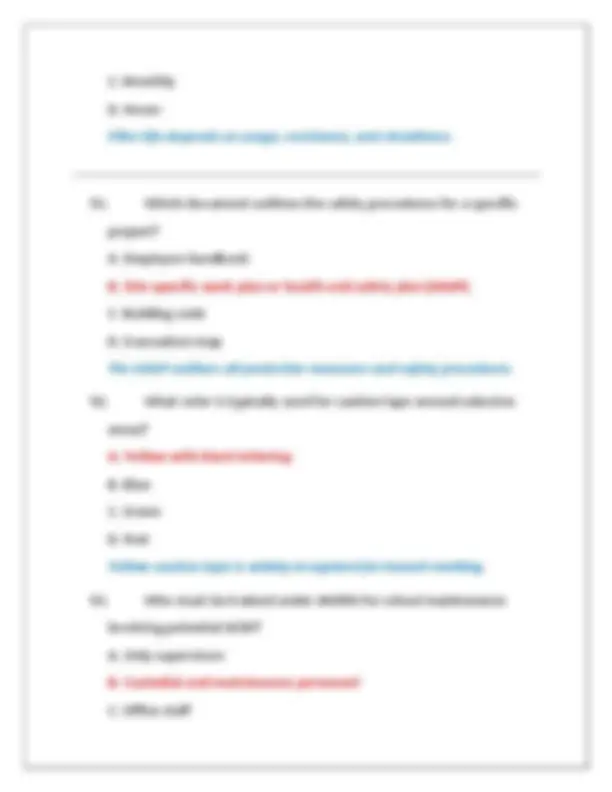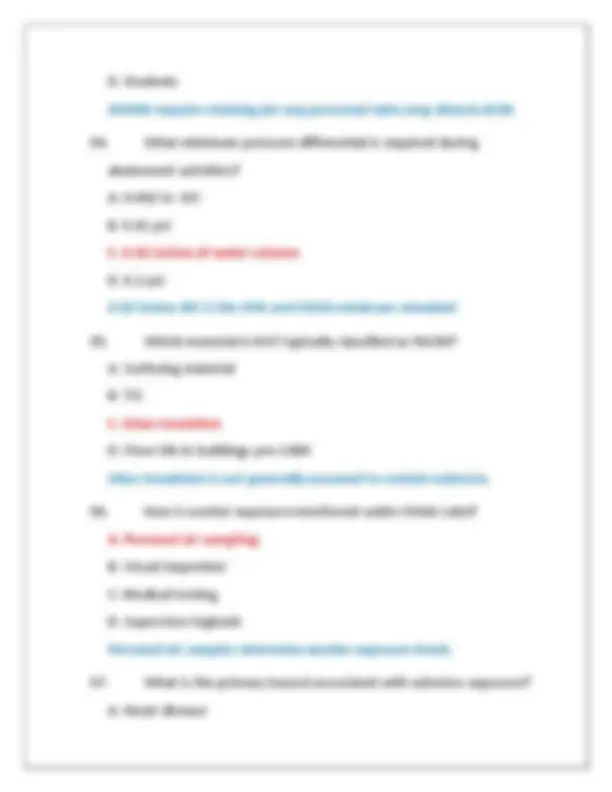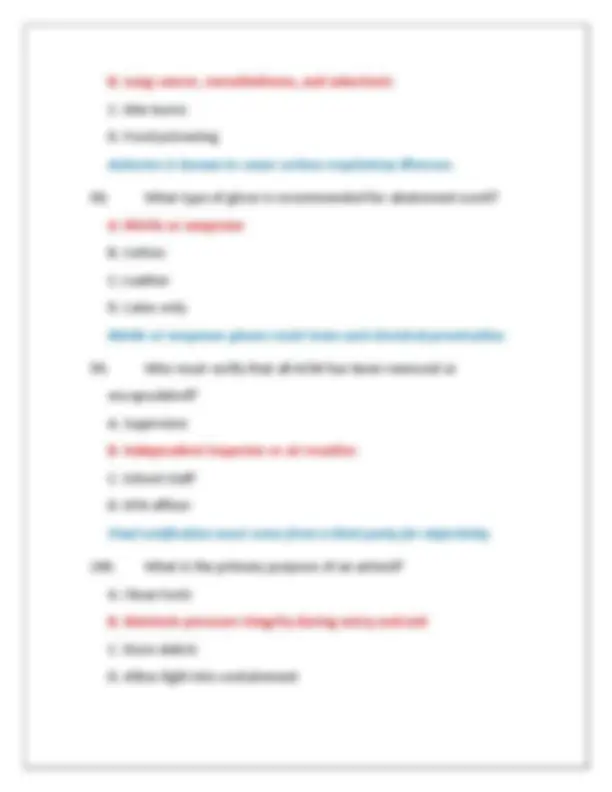Download AHERA CONTRACTOR/SUPERVISOR CERTIFICATION PRACTICE EXAM 1 QUESTIONS AND CORRECT ANSWERS and more Exams Environmental Engineering in PDF only on Docsity!
AHERA CONTRACTOR/SUPERVISOR CERTIFICATION
PRACTICE EXAM 1 QUESTIONS AND CORRECT
ANSWERS (VERIFIED ANSWERS) PLUS RATIONALES
2025 Q&A | INSTANT DOWNLOAD PDF
- What is the primary federal regulation governing asbestos in schools? A. OSHA 1910 B. NESHAP C. AHERA D. TSCA Section 5 AHERA (Asbestos Hazard Emergency Response Act) regulates asbestos management in K-12 schools.
- Which federal agency administers AHERA? A. OSHA B. NIOSH C. EPA D. DOT
The Environmental Protection Agency (EPA) administers and enforces AHERA.
- How often must an accredited asbestos supervisor complete refresher training under AHERA? A. Every 3 years B. Every year C. Every 6 months D. Only once Annual refresher training is required to maintain accreditation.
- Which form must be submitted to notify EPA or delegated state authority before beginning abatement? A. OSHA 301 B. NESHAP Notification Form C. AHERA Form 2 D. Asbestos Exposure Record The NESHAP notification form must be submitted at least 10 working days before demolition or abatement.
- Which of the following is considered a friable asbestos-containing material (ACM)? A. Vinyl floor tile B. Transite panel C. Sprayed-on fireproofing
Negative pressure prevents asbestos fibers from escaping the work area.
- What is the minimum number of air changes per hour required in a negative pressure enclosure? A. 2 B. 4 C. 4 to 6 D. 10 EPA recommends 4 to 6 air changes per hour during abatement.
- What does a HEPA filter remove? A. Only gases B. Large dust particles C. Water vapor D. 99.97% of particles ≥0.3 microns HEPA filters are rated to remove 99.97% of particles that are 0. microns or larger.
- What should be done before beginning an abatement project? A. Pre-clean the area B. Spray encapsulant C. Remove all barriers D. Turn off HEPA units
Pre-cleaning helps to remove dust and debris that could interfere with the work or contaminate air samples.
- What is the primary role of the asbestos supervisor? A. Take air samples B. Oversee worker safety and ensure regulatory compliance C. Write the management plan D. Perform initial inspections Supervisors manage abatement activities and ensure safety and compliance.
- How must asbestos waste be packaged? A. Loose in containers B. Double-bagged in labeled, leak-tight containers C. In boxes D. Wrapped in newspaper Waste must be double-bagged or sealed and properly labeled as asbestos-containing.
- What does the acronym PACM stand for? A. Personal Asbestos Control Manual B. Presumed Asbestos Containing Material C. Protective Air Control Mask D. Potentially Airborne Contaminant Material PACM refers to building materials assumed to contain asbestos without sampling.
D. Storage trailer The decon unit consists of equipment, shower, and clean rooms; a trailer is not required.
- How long should clearance air sampling be conducted after abatement? A. 1 hour B. 2 hours C. Until final air clearance is passed D. 5 minutes Clearance sampling continues until results meet regulatory clearance levels.
- What is glove bag removal used for? A. Small-scale removal from pipes B. Full-scale enclosure C. Roof removal D. Floor tile abatement Glove bags are for small-scale jobs like pipe insulation.
- What is the best method to control airborne asbestos during abatement? A. Fans B. Dry removal C. Wet methods
D. Sweeping Wet methods suppress fiber release during disturbance.
- Which material is exempt from AHERA regulations? A. Pipe insulation B. Residential dwellings C. Floor tile D. Sprayed-on fireproofing AHERA does not apply to private homes or residential buildings with four or fewer units.
- Who must prepare the written project design for a school abatement project? A. Contractor B. Accredited project designer C. State inspector D. EPA representative AHERA requires an accredited project designer to develop designs for abatement in schools.
- Which sign must be posted outside the regulated area? A. No Smoking B. Work Zone Only C. Danger – Asbestos Hazard D. Biohazard Signs must warn of asbestos and restrict access.
A. Final visual inspection and clearance air sampling B. Supervisor signature C. Student health check D. Carpet cleaning AHERA requires both a successful visual inspection and air clearance.
- What triggers OSHA asbestos regulations at a job site? A. Any dust B. Noise C. Potential for employee exposure D. Paint color OSHA applies when workers may be exposed to airborne asbestos fibers.
- How should a HEPA vacuum be maintained? A. Emptied daily B. Used dry only C. Inspected and maintained regularly D. Shared between projects HEPA vacuums must be maintained to ensure filter integrity.
- When must employees be trained under OSHA asbestos standards? A. Before beginning work B. During lunch
C. After completion D. Annually only Training must be completed before potential exposure.
- What is the function of a manometer? A. Check temperature B. Measure negative pressure C. Read pH D. Record noise A manometer measures pressure differentials across containment.
- What color bags are typically used for asbestos waste? A. Blue B. Yellow or red with asbestos warning labels C. Green D. Clear Asbestos waste must be in labeled, colored bags (often red or yellow).
- What should be worn underneath a disposable suit during abatement? A. No clothing B. Light work clothes C. Full PPE D. Shorts Light clothing helps keep workers comfortable and safe.
C. Crocidolite D. Tremolite Chrysotile (white asbestos) is most commonly used in construction.
- What determines the classification of asbestos work? A. Building age B. Material type and scope of work C. Number of workers D. Distance from school Classification is based on the type of ACM and work method.
- What is the maximum time a HEPA vacuum should run during final cleaning? A. 1 minute B. 10 minutes C. As long as necessary to remove contamination D. 30 seconds Cleaning duration depends on contamination level, not time limits.
- What component is necessary for an airtight containment? A. Large fans B. Dehumidifier C. Critical barriers and sealants D. Mirrors Sealants and barriers prevent asbestos fibers from escaping.
- What OSHA document must be kept for each exposed employee? A. W B. Exposure records and medical surveillance C. Birth certificate D. Insurance card Employers must maintain records of employee exposure.
- What determines the need for a regulated area? A. Worker complaints B. Presence or likelihood of airborne asbestos C. Management plan D. Shift length Regulated areas are required where airborne asbestos may be present.
- Which of the following is a thermal system insulation (TSI)? A. Floor tile B. Pipe wrap C. Ceiling panel D. Sheet vinyl TSI includes materials applied to mechanical systems like pipes.
- How must dirty water from decon units be handled? A. Drain into sewer B. Pour in soil
- Who must approve the re-occupancy of a school area after abatement? A. Principal B. Independent air monitor or third-party analyst C. Janitor D. Contractor Independent verification is required under AHERA.
- Which method is required for final visual inspection? A. Flashlight and camera B. Supervisor approval C. Trained inspector checks for debris D. Student review A qualified inspector must perform a final visual inspection.
- What must be done if damaged asbestos-containing material is discovered during a renovation? A. Ignore if not airborne B. Notify occupants C. Stop work and assess the hazard D. Cover with plastic Work must stop immediately to assess and control the hazard according to EPA/OSHA standards.
- Which of the following is NOT an appropriate activity for a contractor/supervisor during abatement? A. Ensuring containment integrity B. Collecting air clearance samples C. Supervising worker safety D. Maintaining negative pressure Clearance samples must be collected by an independent third party, not the contractor.
- Which type of asbestos is also known as "brown asbestos"? A. Chrysotile B. Amosite C. Crocidolite D. Tremolite Amosite is referred to as brown asbestos and is more hazardous than chrysotile.
- When is a glove bag technique permitted? A. On large floor tile jobs B. For short runs of pipe insulation C. During ceiling tile removal D. For wallboard demolition Glove bags are specifically designed for small-scale, short-duration work on pipe insulation.
- What should be done with reusable tools after abatement? A. Discard them B. Decontaminate thoroughly C. Store in truck D. Leave inside containment Reusable tools must be properly cleaned and decontaminated before being reused.
- A critical barrier is used to: A. Provide worker access B. Seal all openings to non-regulated areas C. Increase airflow D. Maintain temperature Critical barriers prevent the release of asbestos fibers into adjoining areas.
- What minimum rating must respirators have for asbestos work? A. N B. R C. P100 or HEPA-rated D. FFP Asbestos respirators must meet P100 or HEPA filter efficiency standards.
- What should happen before removing an HVAC system in an asbestos-contaminated area? A. System must be shut off and sealed B. System should remain operational C. Filters removed and reused D. Open dampers for air movement HVAC systems should be shut off and sealed to prevent fiber spread.
- What level of training is required to supervise asbestos abatement in a school? A. 2-hour awareness B. 8-hour maintenance C. EPA-accredited contractor/supervisor course D. Manufacturer’s instruction Supervisors in schools must complete an EPA-accredited supervisor course under AHERA.
- Which of the following may require additional precautions due to increased risk of fiber release? A. Vinyl floor removal B. Abatement in occupied buildings C. Encapsulation D. Working at night Occupied buildings raise risk for bystanders, requiring enhanced controls.

